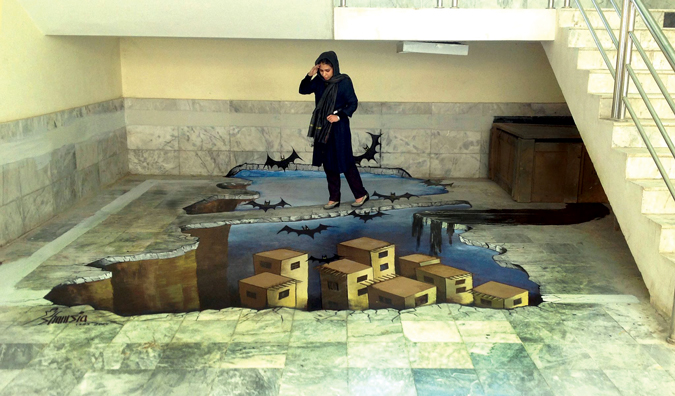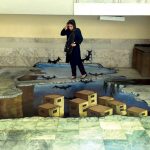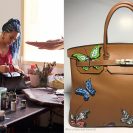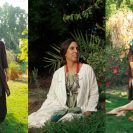The Kabul Art Project
Afghanistan is overflowing with talent but everything works under hushed tones, as the gallery-scene is practically non-existent.
Afghanistan is experiencing new bursts of creativity, resulting in an innovative and experimental art scene. These artists from this conflict zone, are slowly but surely, finding a global voice through Kabul Art Project, which promotes and celebrates a range of talent. The artworks offer a rare experience of cutting-edge, culturally edifying art in the midst of all of the chaos that envelopes the art community. There is a constant challenge for the artists to create openly, let alone exhibit, in a conflict-ridden zone.
It is encouraging to see a positive image of war-ravaged Afghanistan and the artists emerging out of the shadows to express their cultural identity.
Shaking the traditions, a collision of opposites and juxtapositions are some key components that perpetuate Azim Fakhri’s powerful upbeat works. The artist envisions a happy future where the Kalashnikovs will be replaced by guitar, as seen in his hybrid work titled Changes, while in artist Ali Akhlaqi’s surrealist works, identity and assumptions remain a critical element. Similarly, Hamdullah Arbab uses art as a tool for development and peace in the region.
Drawing on his own experience, Rashed Rahmani’s striking, minimalist work titled Bird in the Cage gives ample evidence of his angst on the loss of freedom. The focal point of his artworks is real life experience and human suffering. One encounters umpteen questions on his nuanced narratives that are poetic and delicate and focus on social justice and freedom.
Visually arresting blue Burqa-clad women are central to the work of female graffiti artists Malina Suliman and Shamsia Hassani. Their spirited pieces have carved out a place in art activism with issues that have affinity to their very own issues of identity and gender, conflicting emotions, as well as an allegory for multi-layered reality for a woman that transcends borders at large.
Suliman brings this about very aptly in her series Girl in the Ice Box that explores the multiple roles of women and their position in society. Suliman’s works record the minutiae of a woman’s life punctuated with snippets of complexities and fragility that are raw and revealing, yet delicate in appeal.
In her unique body of work, Hassani gives a new identity to her protagonists and firmly believes that art can bring about a change in the society. Already a known name in graffiti and street art, Hassani was a finalist for the prestigious Artraker Award 2014 for raising awareness through art.
These Afghan artists are coming together and forging new voices and starting a compelling dialogue through their work. The changing landscape of Afghan art is being received very well. Kabul Art Project’s initiatives are undoubtedly a turning point and will be a catalyst to greater interest, understanding, and opportunities for contemporary art from Afghanistan.
Spreading the culture of art and peace, the project works as the bridge that art needs to make in connecting with the world.
Q & ART: Christina Hallmann
Christina Hallmann has put her heart and soul in her project. Speaking with bazaar in an exclusive interview, Hallmann gives us an insight into the Afghan art scene and underlines the dynamic core unique to her Kabul Art Project that aims to bring art closer to the people.
Please tell us a little bit about yourself.
Art and music have led my life, as an active musician, sound engineer and artist, but also on the organizational side as a concert and band promoter and now with Kabul Art Project. I live in Cologne, Germany with my 8-year-old daughter and work as an illustrator and graphic designer.
How did the Kabul Art Project come about?
As a teenager I had a friend from Afghanistan. When I met him again three years ago and after almost 20 years, I started researching Afghanistan, because I realized that I actually knew nothing about it. I made new contacts in Afghanistan through Facebook and my research started with music, film and of course art. But it proved difficult to find anything on Afghan art. I found outdated websites and broken images. The rough idea of Kabul Art Project was born.
A friend of mine in Kabul then went to search for artists and we made contact with the Marefat High School. Zainab Haidary, alumna of the Marefat High School, spread the word about the project to different groups of artists, and so we started with eleven artists from Kabul in January 2013.
How many artists are you supporting currently?
Kabul Art Project is working with 27 artists, 21 of them inside Afghanistan, 4 are currently out of the country for education or as refugees (they lived in Afghanistan at the time the project started), and two artists are permanently living abroad.
Is there a socio-political comment behind the work of these young Afghan artists?
Making contemporary art in Afghanistan is a socio-political comment in and of itself. Most of artistic work was prohibited by the Taliban until 12 years ago under the threat of death penalty. After the fall of the Taliban, a lot has changed, but you can’t turn a switch in the people’s minds, of course, and depending on the place and activity, it still poses a real danger to exercise art. Kabul is more progressive than Herat or Kandahar.
Artist Malina Suliman, who grew up and lived in extremely conservative Kandahar, felt she had to make art to break out and affronted the Taliban, who followed, threatened and even hurt her family last year. Some artists follow their socio-political concept and intentionally want to use their art to change the situation in Afghanistan for the better, like the graffiti artists Shamsia Hassani and Malina Suliman or activists Azim Fakhri and Hamdullah Arbab. But for many artists I feel it is especially a way to be personal and to express themselves, tell their story and process their experiences.
How do you envisage the future of female artists trying to raise issues through art in Afghanistan?
Art is Freedom – not only for female artists. I think, the situation for female artists in Afghanistan remains delicate, especially in more conservative areas. The security situation worsened in the past few years and in some areas the Taliban gained more power again, on the other hand, the number of female artists is growing and they definitely have an impact on other women.
How do you support these artists?
I promote their artworks on a daily basis through social media and our website. We’ve had three exhibitions and Kabul Art Project is a constant and easy to find contact point for media, exhibitors, art buyers and other art projects. But the artists also get individual support, if they need something.
The only thing, that Kabul Art Project can’t provide is financial support, at least not yet. My work for this project is voluntary and the expenses are barely covered. But with our next steps I hope to change this, so that Kabul Art Project can bring long-term plans into operation.
Can you tell us a bit about the future projects that you would like to venture into?
The next steps we are going to do with Kabul Art Project are the publishing of Artist Books, more exhibitions and the shooting of a documentary film about our artists. At the moment we are trying to raise the funds for these steps with a crowdfunding campaign on Indiegogo.
If Kabul Art Project can reach a larger public, we might be able to implement the plans like organizing workshops, renting working places, giving out scholarships and also perform campaigns in Afghanistan that should bring art closer to the people.
KAP has taken great strides in encouraging emerging talent. If you would also like to make a difference, log on to www.kabulartproject.de for more details. Images courtesy of Kabul Art Project.













